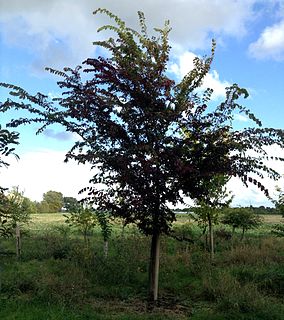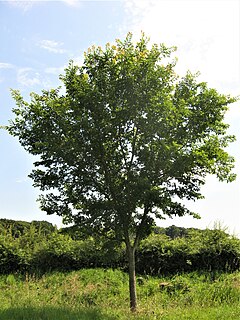Related Research Articles

Ulmus 'Frontier' is an American hybrid cultivar, a United States National Arboretum introduction derived from a crossing of the European Field Elm Ulmus minor with the Chinese Elm Ulmus parvifolia in 1971. Released in 1990, the tree is a rare example of the hybridization of spring- and autumn-flowering elms. Tested in the US National Elm Trial coordinated by Colorado State University, 'Frontier' averaged a survival rate of 74% after 10 years.

Ulmus 'Homestead' is an American hybrid elm cultivar raised by Alden Townsend of the United States National Arboretum at the Nursery Crops Laboratory in Delaware, Ohio. The cultivar arose from a 1970 crossing of the Siberian Elm Ulmus pumila with the hybrid N 215, the latter grown from seed sent in 1960 to the University of Wisconsin-Madison elm breeding team by Hans Heybroek of the De Dorschkamp Research Institute in the Netherlands. Tested in the US National Elm Trial coordinated by Colorado State University, 'Homestead' averaged a survival rate of 85% after 10 years. 'Homestead' was released to commerce without patent restrictions in 1984.

The hybrid elm cultivar Ulmus × hollandica 'Pioneer' is an American clone arising from the crossing of two European species, Wych Elm U. glabra and Field Elm U. minor. Raised by the USDA station at Delaware, Ohio, in 1971, 'Pioneer' was released to commerce in 1983.

Ulmus 'Regal' is an American hybrid elm cultivar developed by the University of Wisconsin–Madison and released in 1983. 'Regal' was derived from seeds arising from the crossing of the Dutch hybrid clones 'Commelin' and '215' sent in 1960 by Hans M. Heybroek of the Dorschkamp Research Institute for Forestry & Landscape Planning, Wageningen, Netherlands.

Ulmus 'Morton Glossy' is a hybrid cultivar raised by the Morton Arboretum, Illinois. Originally named 'Charisma' until it was realized that name had already been registered for another plant, the tree was derived from a crossing of two other hybrid cultivars grown at the Morton: Accolade and Vanguard. Tested in the US National Elm Trial coordinated by Colorado State University, Triumph averaged a survival rate of 86% after 10 years. Triumph was introduced to the UK in 2006 by the Frank P. Matthews nursery in Worcestershire.
Ulmus 'Morton Plainsman' is a hybrid cultivar raised by the Morton Arboretum from a crossing of Siberian Elm and a Japanese Elm grown from openly pollinated seed donated by the Agriculture Canada Research Station at Morden, Manitoba. Tested in the US National Elm Trial coordinated by Colorado State University, Vanguard averaged a survival rate of 78% after 10 years.

Ulmus 'Morton Red Tip' is a hybrid cultivar raised by the Morton Arboretum from an open pollination of Accolade. The tree has occasionally been reported as a hybrid of Accolade with the Siberian Elm Ulmus pumila, an error probably owing to the commercial propagation of the tree by grafting onto U. pumila rootstocks. Tested in the US National Elm Trial coordinated by Colorado State University, Danada Charm averaged a survival rate of 77.5% after 10 years.

The American Elm cultivar Ulmus americana 'New Harmony' was raised by the Maryland Agricultural Research Service and released by the United States National Arboretum in 1995, along with 'Valley Forge'. 'New Harmony' proved the most successful U. americana cultivar in the US National Elm Trial, averaging a survival rate of 85.5% overall.

The American Elm cultivar Ulmus americana 'Jefferson' was cloned from a tree that grows along the National Mall in Washington D. C.. Planted in the 1930s, it remains (2013) unscathed by Dutch elm disease, and was cloned by the U. S. National Park Service, which released it as 'Jefferson' in 2004. Early studies on this clone indicated triploid chromosome levels, suggesting it may be a hybrid between the tetraploid American Elm and a diploid species. A genetic study performed by the United States National Arboretum in 2004 confirmed the tree as Ulmus americana, despite its atypical features. A later study by the USDA's Agricultural Research Service confirmed the tree as a triploid, but derived from a crossing of two American Elms, one a tetraploid, the other a rarer diploid.
The Chinese Elm cultivar Ulmus parvifolia 'UPMTF' was raised by Moon's Tree Farm nursery, Atlanta, United States.
The Chinese Elm cultivar Ulmus parvifolia 'Burgundy' is a small American development.

The Chinese Elm cultivar Ulmus parvifolia 'Emer II' or 'Emerald Vase' was cloned from a tree planted circa 1910 on the University of Georgia campus at Athens.
The Chinese Elm cultivar Ulmus parvifolia 'A. Ross Central Park' is probably the hardiest in cultivation and was patented in 1989 by David F. Karnosky. The original tree grew near the entrance to Central Park, at the junction of Fifth Avenue and 72nd Street in the Upper East Side of Manhattan in New York City, and died in the 1990s aged over 100 years. The cloning project was initiated in 1976 by the Arthur Ross Foundation, and executed by the School of Forestry and Wood Products, Michigan Technological University, Houghton.
The Chinese Elm cultivar Ulmus parvifolia 'Dynasty' is a United States National Arboretum introduction reputed to be very fast-growing.
The Chinese Elm cultivar Ulmus parvifolia 'Hallelujah' is one of three American introductions made circa 1992 that were selected for their cold hardiness. 'Hallelujah' is known to have withstood -37°C (-35°F) in Missouri.
The Chinese Elm cultivar Ulmus parvifolia 'Pathfinder' is another development by A. M. Townsend of the USDA National Arboretum registered in 1990.

The Chinese Elm cultivar Ulmus parvifolia 'Sempervirens' is an American introduction, commonly known by the synonym 'Evergreen', and may also be in synonymy for U. parvifolia 'Pendens'.

Ulmus 'Patriot' is a hybrid cultivar raised by the United States National Arboretum in 1980. Derived from a crossing of the American hybrid 'Urban' with the Wilson's Elm cultivar 'Prospector', 'Patriot' was released to commerce, free of patent restrictions, in 1993. Tested in the US National Elm Trial coordinated by Colorado State University, 'Patriot' averaged a survival rate of 85% after 10 years.
The Chinese Elm cultivar Ulmus parvifolia 'BSNUPF' was raised by John Barbour of Athena Trees, Monroe, Georgia.

Ulmus parvifolia, commonly known as the Chinese elm or lacebark elm, is a species native to eastern Asia, including mainland China, Taiwan, Japan, North Korea, South Korea and Vietnam. It has been described as "one of the most splendid elms, having the poise of a graceful Nothofagus".
References
- ↑ Santamour, Frank S.; Bentz, Susan E. (May 1995). "Updated Checklist of Elm (Ulmus) Cultivars for use in North America". Journal of Arboriculture. 21 (3): 122–131. Retrieved 20 June 2016.
- ↑ "Ulmus parvifolia 'Emer I' = ATHENA". JC Raulston Arboretum. Retrieved 2018-08-01.
41677
- ↑ ca.uky.edu, Plant Pathology, Ulmus parvifolia 'Emer I' = ATHENA
- ↑ "Elm Leaf Beetle Survey". Archived from the original on 2011-07-19. Retrieved 17 July 2017.
- ↑ Brady, C., Condra, J., & Potter, D. (2008) Resistance of Landscape-suitable Elm (Ulmus spp.) Cultivars to Japanese Beetle, Leaf Miners, and Gall Makers. 2008 Research Report, Nursery & Landscape Program, pp 15, 16. University of Kentucky.